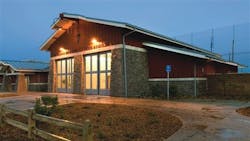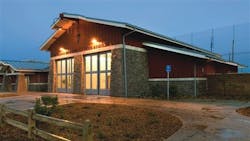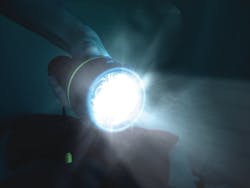Newsworthy
What FMs Need to Know about MRSA
As MRSA cases make headlines across the nation, facilities professionals should be asking themselves what they can do to prevent the spread of infection. The following information from Stan Weller, vice president, research & development, at Atlanta-based Zep Inc., provides a heads-up on how to keep your tenants healthy.
Buildings: Why should facilities professionals be concerned about MRSA infections?
Weller: Methicillin-resistant Staphylococcus aureus (MRSA) has been a problem since the 1960s. About 20 percent of bloodstream infections in hospital settings have been caused by Staphylococcus aureus. Now, community-acquired MRSA has become the most frequent cause of skin and soft-tissue infections presented to emergency rooms in the United States.
According to the Atlanta-based Centers for Disease Control and Prevention (CDC), factors that have been associated with the spread of MRSA skin infections include close skin-to-skin contact, openings in the skin (such as cuts or abrasions), contaminated items and surfaces, crowded living conditions, and poor hygiene - all of which may be present in commercial and institutional buildings. Recent reports have noted that some institutional facilities have had to shut down for a period of time in the wake of MRSA outbreaks.
Buildings: What should facility managers and janitorial staffs know about preventing the spread of infection in their buildings?
Weller: Proper hand washing and sanitizing is the single most important step in preventing the spread of infectious diseases like MRSA. FMs and janitorial staffs should make sure that restrooms, breakrooms, and lunchrooms are well stocked with plenty of hand soap and hand towels. Providing waterless hand sanitizers in other public spaces will encourage building tenants and visitors to frequently sanitize their hands.
Frequently and properly clean and sanitize - especially "high-touch" surfaces like elevator buttons, phones, stair rails, doorknobs, and countertops. Choose cleaners and sanitizers that are EPA registered and approved to kill the MRSA germ.
In facilities such as schools, gyms, and health clubs, FMs and janitors may want to post information encouraging people not to share personal items such as towels and razors; to keep cuts and scrapes clean, and covered with a bandage until healed; and to use a barrier (clothing or towel) between skin and shared equipment.
Buildings: Where can facility managers go for more information?
Weller: The CDC (www.cdc.gov) offers a wealth of information, educational materials, prevention strategies, and treatment tips.
Firefighters' Complex Completed Despite Early Setbacks
The Santa Ana Heights Fire Station and Fire Training Facility in Newport Beach, CA, has been completed by Irvine, CA-based gkkworks. An 11,027-square-foot complex costing $7 million, the project was challenged early on by pre-existing underground utilities not shown on any existing plans.
"Abandoned asbestos piping, septic tank and cesspool, and other unforeseen conditions made this project difficult in the early stages," says Eric Stones, construction manager for gkkworks. While these surprises could have caused a delay in the construction schedule, the project team managed to stay on track.
The rustic-looking, 30-room complex includes a 4,000-square-foot, 4-story training tower that is equipped with a confined-space area, smoke machine, roof vent, rappelling apparatus, and space for training exercises. This is Newport Beach's first new fire station since the last one was built 10 years ago on Balboa Island.
Research Finds Viable Product in Recycled Roofing Membrane
The Bethesda, MD-based EPDM Roofing Association (ERA) recently announced the completion of the first phase of its project to research the possible recycling of EPDM single-ply roofing material. The results indicate that it is logistically viable to remove EPDM from a roof and create a product from recycled membrane.
By the end of 2007, nearly 1 million feet of EPDM was located, removed, transported, ground, and reused. The material was removed from roofs with loose-laid membrane covered by ballast or mechanically fastened systems.
"While there is still work to be done," says Mike DuCharme, chairman of ERA's board of directors, "we believe that we have developed a viable system for removing and reusing much of the EPDM membrane that will be ready for replacement in the coming years."
The next phase of the project will focus on expanding the geographic range from which material will be gathered, adding other grinders, determining the amount of material that will be available on an ongoing basis, and creating a likely cost structure.
"Given the widespread use of EPDM over the past 40 years, we recognize that a significant amount of membrane could end up in a recycling pipeline," says Jim Jannasch, a member of ERA's technical committee.
Nonresidential Construction Job Growth Offsets Housing Slump
According to Ken Simonson, chief economist for Washington, D.C.-based The Associated General Contractors of America (AGC), nonresidential construction employment grew in late 2007, belying the notion that the ongoing housing slump is dragging down all construction.
A payroll employment report from the Bureau of Labor Statistics (BLS) shows that, although total construction employment fell in October, nearly all of those losses occurred in homebuilding.
"The BLS numbers show that, over the past 12 months, employment in the three nonresidential categories (nonresidential building, specialty trades, plus heavy and civil engineering) climbed 42,000, or 1 percent," Simonson adds. "At the same time, employment in residential building and specialty trades dropped by 148,000 jobs, or 4.4 percent," he says. "But, that estimate greatly understates the actual difference. Census Bureau figures for September show that residential construction spending was down 16 percent from a year before, and nonresidential was up almost 17 percent. It's likely that residential employment is actually down roughly 16 percent. That means about 400,000 ‘residential' specialty trade contractors are now doing nonresidential electrical, plumbing, and other work." Considering this fact, nonresidential employment is figured to actually be up more than 10 percent.
New Main Library Opens for City of Lincoln, CA
Construction is complete on the Lincoln Public Library at Twelve Bridges, which will serve as the new main library for Lincoln, CA.
Designed by Los Angeles-based NTD Architecture as part of the Twelve Bridges Learning Center master plan, the 39,311-square-foot facility includes designated areas for adults, young adults, children, and periodicals, as well as a computer lab, homework center, media and reference areas, group study areas, and a community room. "Lincoln is one of the fastest-growing cities in California," says Jordan S. Knighton, partner at NTD Architecture. "We are proud to play such a crucial role in its development."
Construction began on the library in August 2006; the facility opened its doors in late 2007.
Update to AIA Contract Documents Released
Toward the end of last year, the Washington, D.C.-based American Institute of Architects (AIA) released its 2007 Update to AIA Contract DocumentsTM, which have defined the contractual relationships in the design and construction industry for 120 years. The AIA prepared the 2007 update, which consists primarily of agreements in the popular A201 family of documents, with input from owners, contractors, attorneys, architects, and engineers. The 2007 Update includes 40 revised, updated, or new documents, including new owner/architect agreements.
Significant changes were made to A201, the backbone of the A201 family of documents, because it forms the relationship between the owner, contractor, and architect. The 2007 Update also includes major changes concerning arbitration and the statute of limitations, and offers new owner/architect agreements. More information can be found at (www.aia.org).
Retrofitting Sprinklers, Smoke Detectors, and Carbon-Monoxide Detectors
Currently, numerous National Multi Housing Council (NMHC) and National Apartment Association (NAA) firms and affiliates are being pressed to retrofit their existing apartments with sprinklers and smoke detectors. In many cases, the local officials are basing the decision on what they think the codes require, resulting in misinformation.
Building and fire codes are designed for new construction and are to be enforced from the date of adoption forward. The codes are not intended to be retroactive unless the provisions in the code specifically say they are intended for existing buildings.
Intl. Building Code (IBC) and Intl. Fire Code (IFC) Requirements. The IBC, which is the code used almost exclusively across the country, does not have any retroactive requirements of any kind for sprinklers or smoke detectors. Likewise, the IFC does not have any requirements for retrofitting of sprinklers, but it does have requirements for retrofitting of smoke detectors. There are no requirements in the IBC or IFC for carbon-monoxide detectors.
National Fire Protection Association (NFPA) Life Safety Code 101 Requirements. If you are obliged to comply with NFPA 101, the provisions for existing apartment buildings are covered in Chapter 31. NFPA 101 does not have any requirements to retrofit sprinklers. Section 31.3.4.5.1 does require single-station smoke alarms outside every sleeping area in the immediate vicinity of the bedrooms and on all levels of the dwelling unit, but these can be battery operated. There are no requirements for carbon-monoxide detectors.
Federal Requirements. There are no federal requirements to retrofit sprinklers, smoke detectors, or carbon-monoxide detectors. There is a proposal, the Fire Sprinkler Incentive Act, which proposes allowing accelerated depreciation for fire-sprinkler systems that are retrofitted into existing buildings. There is also a move by the Centers for Medicare and Medicaid Services to require the retrofit of sprinklers in all existing nursing homes.
REITs Can Cut Carbon Emissions with Solar Rooftops
There is enough U.S. rooftop real estate controlled by institutional owners, including publicly owned real estate investment trusts (REITs), to generate 15,000 megawatts of solar power - and these owners have the opportunity to cut the carbon emissions of their properties by as much as 50 percent, according to Recurrent Energy, a San Francisco-based solar services provider.
The U.S. Environmental Protection Agency has found that electricity usage is the single largest source of carbon emissions for commercial buildings. Considering only those rooftops controlled by institutional investors where solar can be cost effective, 15,000 megawatts of new solar electric generation would mean annual avoided emissions roughly equal to taking 3 million cars off the road.
"Organizations that own a substantial portfolio of commercial buildings have a critical role to play in reducing U.S. greenhouse-gas emissions," says Craig Cornelius, program manager for the U.S. Department of Energy's Solar Energy Technologies Program. "Rooftop solar energy is an ideal building enhancement, providing on-site, pollution-free electricity."
More information can be found at (www.recurrentenergy.com).
NEMA Publishes CFL White Paper
A white paper that can provide facility managers and building owners with important information regarding compact fluorescent lamps (CFLs) has been published by the Rosslyn, VA-based National Electrical Manufacturers Association (NEMA). Discussing po-tential issues that may arise when some four-pin spiral CFLs are operated in luminaires that aren't specifically approved or third-party safety-listed for use with such lamps, Four-Pin Spiral Compact Fluorescent Lamp Systems Issues, Recommendations, and Standardization covers industry plans to include this emerging lamp type in proposed U.S. national consensus standards. The paper can be downloaded free of charge at (www.nema.org/stds/LSD39.cfm).
City Adopts Climate Action
In late October 2007, people in Colorado started breathing a little easier. Denver Mayor John Hickenlooper adopted the city council's climate action plan (dubbed "Greenprint Denver") to make the metro area more sustainable and also signed Executive Order 123, establishing the city's sustainability policy. "The climate action plan will guide Denver's efforts to reduce greenhouse-gas emissions while creating jobs and improving public health," says Hickenlooper.
Greenprint Denver was created in July 2006. "Our goal is to maintain all of our city facilities in an energy-efficient and sustainable manner," says Kevin Patterson, manager of general services for the City and County of Denver. "Sustainability is not just a buzzword - it is an integral part of our decision-making process."
The climate action plan offers 10 recommendations for reducing greenhouse-gas emissions, including:
- Develop outreach campaigns to conserve energy, buy renewable energy, and support public transportation.
- With voter approval, conserve energy by applying a tiered rate structure to the use of electrical and natural gas. Tiered rates would impose a premium charge for excessive energy use.
- Make city buildings, including Denver Intl. Airport, and vehicles more energy efficient.
- Expand recycling initiatives.
- Adopt mandatory energy-efficient building codes for commercial structures.
- Require use of green concrete, which includes fly ash, in all public and private construction projects.
The original information on Denver's climate action plan ran in the Denver Business Journal; more information can be found at (www.greenprintdenver.org).
Hard-Surface Flooring Demand Projected
U.S. demand for hard-surface flooring is projected to increase by 3.9 percent yearly, reaching 11.9 billion square feet in 2011, which is valued at $13.5 billion, according to a new study by The Freedonia Group Inc., Cleveland. The study indicates that laminate flooring will experience the strongest growth (supported by easier installation, improved durability, and realistic designs). Vinyl flooring is expected to remain the leading hard-surface floorcovering (due to its low price, wide selection range, and application versatility), with 33 percent of the market in 2011; however, it will be losing ground to laminates, ceramic tile, and wood flooring.
ASHRAE Survey Reveals Trends
A recent survey in the ASHRAE Journal, published by the Atlanta-based American Society of Heating, Refrigerating, and Air-Conditioning Engineers (ASHRAE), details industry trends for the future. AHR Expo 2008 exhibitors (1,300) and pre-registered attendees (10,500) were surveyed.
When asked about top concerns about purchasing HVAC products, the attendees noted that first cost ranked as the most important concern (68 percent), followed by reliability (65 percent), energy efficiency (64 percent), and comfort (54 percent). The survey also indicated that healthcare is expected to be a strong market segment this year, followed by large commercial.
Elevators Considered in Fire Evacuations
"In case of fire, use the stairs, not the elevator" appears on signs posted in elevator lobbies throughout the United States. In the aftermath of 9/11, however, experts are starting to reconsider tall building evacuation strategies.
In 2007, the Gaithersburg, MD-based National Institute of Standards and Technology (NIST) recommended code changes to increase elevator use in high-rise emergencies in the report of its 3-year investigation of the World Trade Center (WTC) collapses; in April 2008, NIST will sponsor a conference to consider the benefits of elevator evacuations, including the advantages for people with disabilities.
Elevator systems in modern high-rise commercial buildings are designed to move a building's entire population in or out of the building in 1 hour or less. In emergencies, elevators could be programmed to first move those with the longest distance to go. People with disabilities would not need to be given any priority since all occupants would be accommodated equally in this system.
U.S. building codes are currently considering proposals to require such elevators in tall buildings, and regulators in several countries are interested in requiring evacuation elevators as part of their disability regulations.
LEDs as Stun Lights?
LEDs are finding their way into myriad applications, but one of the most unusual is the recent LED Incapacitator, a flashlight designed to disorient and nauseate anyone who is subjected to its strobe-like beam.
According to the U.S. Department of Homeland Security, two physicists are working on the flashlight, which carries with it a mission: to force someone to look away and recover his/her bearings, giving law enforcement authorities an opportunity to gain the upper hand. What makes this instrument so disturbing to the human target is that the colors and pulses continuously change, so the brain can't adjust, which promotes feelings of nausea and disorientation.
The target roll-out year for use by police, border patrol agents, and anti-terrorism agents is 2010 - but who knows how soon your building's security guards could be wielding these nonviolent LED weapons?
Office Plants Fight Sickness, Improve IAQ
Are you experiencing headaches at work? Fatigue? What about a sore throat? You should stop and smell the roses - seriously. According to the Loveland, OH-based nonprofit group Green Plants for Green Buildings (GPGB), the building in which you work could be making you sick, and plants can help.
Wolverton Environmental Services, based in Picayune, MS, has identified the toxins found in everything from common office draperies to the VDU computer screen. Wolverton found that one of the factors influencing VOC-removal rate involves plants and how they remove harmful toxins from the air through transpiration (when water evaporates from a plant's leaves). A study by RA Wood, MD, titled Plants/Soil Capacities To Remove Harmful Substances From Polluted Indoor Air, identifies which plants are best at removing the top toxins found in most indoor environments.
Dr. Tjove Fjeld, a professor at the Agricultural University of Oslo, Norway, conducted a 2-year study in an office building; the study found significant reductions (23 percent) in ailments after plants were introduced. The reduction of ailments has translated to a 14-percent reduction in absenteeism. To facilities professionals who are trying to keep tenants successful and buildings occupied, this is a vital statistic.
While plants aren't powerful vacuum cleaners that suck contaminants from across a large room, placing them where people spend the most time (in a cubicle, near a computer, or in the kitchen) can bring quantifiable results. Also, the healthier the plants, the better job they'll do at reducing pollutants. GPGB suggests considering professional interiorscapers to specify plants and vegetation for your building. For more information, go to (www.gpgb.org).








